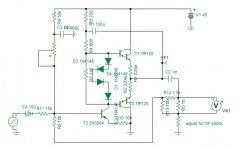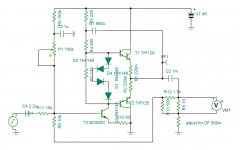I don't think the goal is meant to design for 0.2% THD at 10W with 3 transistors.
0.2% for 1W into 8R is more realistic.
Cheers,
Patrick
0.2% for 1W into 8R is more realistic.
Cheers,
Patrick
The circuits shown on post 37 has 1.4% /10w of odd order harmonics of opposite phase , better than absolute 0% distortion as it subtracts with that of the speaker and recovers the dynamic.I don't think the goal is meant to design for 0.2% THD at 10W with 3 transistors.
0.2% for 1W into 8R is more realistic.
Cheers,
Patrick
I suggest you consider using prepackaged Darlington transistors instead of using two discrete transistors. In your circuit, they are required to behave identically.
"The attached spice file is nothing more than an illustration how it might be made to work."
Cheers,
Patrick
Cheers,
Patrick
Hi,The circuits shown on post 37 has 1.4% /10w of odd order harmonics of opposite phase , better than absolute 0% distortion as it subtracts with that of the speaker and recovers the dynamic.
In the circuit you did, will need 5 diodes. Instead of 4 to push it into class AB. The resistor at the emitter of the power transistor. should be something like 1 or 2 ohms to have a bias current of a few hundred miliamps .
The bias seems a bit off. Seems the bias divider is about 5X but the DC gain seems like 10X. Is the output voltage about half of Vcc?
I would like to give your circuit a shot, as soon as I figure out how it works.
Last edited:
The bias with Darlington I adjusted about 120ma , with MOSFETS ,60ma. Emitter resistors are only for thermal stability.Hi,
In the circuit you did, will need 5 diodes. Instead of 4 to push it into class AB. The resistor at the emitter of the power transistor. should be something like 1 or 2 ohms to have a bias current of a few hundred miliamps .
The bias seems a bit off. Seems the bias divider is about 5X but the DC gain seems like 10X. Is the output voltage about half of Vcc?
I would like to give your circuit a shot, as soon as I figure out how it works.
The Intention is to have zero damping factor as he explains the need for his high efficiency speakers . In other words he needs trans Conductance amplifier.Does it qualify as "no global feedback" ?
Patrick
I think zero damping factor is too much to ask for. That is basically current source amplifier. I have 2 already in class A. An F2J and a inductor based amp. Just looking to have something with a low damping factor. From what I understand, global feedback increases the damping significantly, hence I am avoiding there. The sound signature is also suppose to be different.
Oon
Oon
Depends on how you define "low" damping factor.
For example, Zout for post #39 is 0.09R.
But you can easily increase that to any desired value by adding emitter resistors.
Cheers,
Patrick
For example, Zout for post #39 is 0.09R.
But you can easily increase that to any desired value by adding emitter resistors.
Cheers,
Patrick
I think zero damping factor is too much to ask for. That is basically current source amplifier. I have 2 already in class A. An F2J and a inductor based amp. Just looking to have something with a low damping factor. From what I understand, global feedback increases the damping significantly, hence I am avoiding there. The sound signature is also suppose to be different.
Oon
You can use global feedback to set the damping factor to whatever you want, total control. Feed back (a sample of) the output voltage for low output impedance = high damping factor, or feedback (a sample of) the output current for high output impedance = low damping factor.
Could even use a continuously variable pot to go from low to high damping factor.
Or use a series R at the output of a low output impedance amp ;-)
Jan
If you are prepared to go beyond 3 transistors and single rail, then the Pioneer Super Linear would be high on my list :
https://www.diyaudio.com/forums/hea...oneer-super-linear-circuit-3.html#post5296297
https://www.diyaudio.com/forums/hea...oneer-super-linear-circuit-3.html#post5296415
(post #112, 113)
Of course you can also use a pair of Sziklai's instead of Darlingtons.
Cheers,
Patrick
https://www.diyaudio.com/forums/hea...oneer-super-linear-circuit-3.html#post5296297
https://www.diyaudio.com/forums/hea...oneer-super-linear-circuit-3.html#post5296415
(post #112, 113)
Of course you can also use a pair of Sziklai's instead of Darlingtons.
Cheers,
Patrick
The title says "no global feedback" ?
😉
Patrick
... because he thinks it will give high damping. It doesn't seen he is against it in principle ;-)
Jan
Since we are on the subject, maybe this will also be fun for you :
https://www.diyaudio.com/forums/pass-labs/325037-faow.html#post5492361 (post #47)
https://www.diyaudio.com/forums/pass-labs/325037-faow-2.html#post5492720 (post #73)
https://www.diyaudio.com/forums/pass-labs/325037-faow-3.html#post5494704 (post #101)
https://www.diyaudio.com/forums/pass-labs/325037-faow-3.html#post5494938 (post #116)
Cheers,
Patrick
https://www.diyaudio.com/forums/pass-labs/325037-faow.html#post5492361 (post #47)
https://www.diyaudio.com/forums/pass-labs/325037-faow-2.html#post5492720 (post #73)
https://www.diyaudio.com/forums/pass-labs/325037-faow-3.html#post5494704 (post #101)
https://www.diyaudio.com/forums/pass-labs/325037-faow-3.html#post5494938 (post #116)
Cheers,
Patrick
Post 2 repeatedYou try first a series resistor with your speaker driven with a standard amplifier to determine the required damping factor. The circuit you show has a relatively low output impedance, but adding a bootstrap you get near zero DF and higher gain . You can also apply negative current feedback on an "normal " amplifier to lower the DF.
- Home
- Amplifiers
- Solid State
- Suggestions for simple class AB with no global FB.


